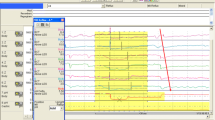Abstract
Acid clearing, the interval while intraesophageal pH is <4 after a traditional acid reflux event (RE), is a potential “blind spot” during pH monitoring, when reflux of acidified gastric contents may occur undetected by the pH probe. This is termed “acid rereflux.” Acid rereflux comprised 61% (169/262) of acid REs in recumbent postprandial patients with severe GERD in two reports using simultaneous pH monitoring and manometry as well as multichannel intraluminal impedance (MII) in one, and scintigraphy in the other. Acid rereflux events often recurred with short intervals between them. The pH probe alone was insufficient to detect most acid rereflux REs, since expanding pH criteria for an acid RE (>1 unit fall while pH < 4) detected only 35% of acid rereflux REs. When a variety of patients and study conditions was examined, simultaneous manometry–pH monitoring found more frequent acid rereflux in the following situations: (1) patients with vs those without esophagitis; (2) recumbent vs upright posture, and (3) postprandial vs preprandial. Of pathophysiologic importance, acid rereflux in the blind spot is the most common cause of prolonged daytime acid REs in GERD patients. Of clinical importance, the 24-hr pH parameter “% acid exposure” should be relied upon most in interpreting the 24-hr pH record, because those parameters that relate to RE frequency may be inaccurate due to acid rereflux REs that are not counted. Furthermore, identifying as many REs as possible gives a more reliable indication of the severity of antireflux barrier incompetence, as well as more REs to correlate with patients symptoms that should improve sensitivity of the symptom index. Ambulatory simultaneous pH monitoring and MII will allow these and other roles for acid rereflux to be assessed during the patients normal day.
Similar content being viewed by others
REFERENCES
Richter JE, Castell DO: Gastroesophageal reflux. Pathogenesis, diagnosis, and therapy. Ann Intern Med 97:93-103, 1982
Johnson LF, Demeester TR: Twenty-four-hour pH monitoring of the distal esophagus. Quantitative measure of gastroesophageal reflux. Am J Gastroenterol 62:325-332, 1974
Helm JF, Dodds WJ, Pelc LR, Palmer DW, Hogan WJ, Teeter BC. Effect of esophageal emptying and saliva on clearance of acid from the esophagus. N Engl J Med 310:284-288, 1984
Vela M, Camacho-Lobato L, Srinivasan R, Tutuian R, Katz P, Castell DO: Simultaneous intraesophageal impedance and pH measurement of acid and nonacid gastroesophageal reflux: Effect of omeprazole. Gastroenterology 120:1599-1606, 2001
Sifrim D, Holloway RH, Silny J, Xin Z, Tach J, Leure T, Janssens J: Acid, non-acid and gas reflux in patients with gastroesophageal reflux disease during 24-hr ambulatory pH-impedance recordings. Gastroenterology 120:1588-1598, 2001
Kahrilas P: Will impedance testing rewrite the book on GERD? Gastroenterology 120:1862-1864, 2001
Shay SS, Eggli D, Johnson LF: Simultaneous esophageal pH monitoring and scintigraphy during the postprandial period in patients with severe reflux esophagitis. Dig Dis Sci 36:558-564, 1991
Shay SS, Bolemi S, Richter JE: Multichannel Intraluminal Impedance: Accuracy in detecting fasting reflux events compared to pH probe and manometry. Am J Physiol Gastrointest Liver Physiol 283:G376-G383, 2002
Shay SS, Johnson LF: Upright refluxers without esophagitis differentiated from biopsitional refluxers with esophagitis by simultaneous manometry and pH monitoring in two postures before and after a meal. Am J Gastroenterol 89:992-1002, 1994
Schoeman MN, Tippett MD, Akkermans LM, Dent J, Holloway RH: Mechanisms of gastroesophageal reflux in ambulant healthy human subjects. Gastroenterology 108:83-91, 1995
Dent J, Holloway RH, Toouli J, Dodds WJ: Mechanisms of lower oesophageal sphincter incompetence in patients with symptomatic gastrooesophageal reflux. Gut 29:1020-1028, 1988
Mittal RK, McCallum RW: Characteristics and frequency of transient relaxations of the lower esophageal sphincter in patients with reflux esophagitis. Gastroenterology 95:593-599, 1988
Corazziari E, Bontempo I, Anzini F, Torsoli A: Motor activity of the distal oesophagus and gastroesophageal reflux. Gut 25:7-13, 1984
Sifrim D, Silny J, Holloway RH, Janssens J: Patterns of gas and liquid reflux during transient lower esophageal sphincter relaxation: a study using intraluminal electrical impedance. Gut 44:47-54, 1999
Dodds WJ, Kahrilas PJ, Dent J, Hogan WJ, KernMK, Arndorfer RC: Analysis of spontaneous gastroesophageal reflux and esophageal acid clearance in patients with reflux esophagitis. J Gastrointest Motil 2:79-89, 1990
Dent J, Dodds W, Friedman R, Sekiguchi T, Hogan WJ, Arndorfer RC, Petrie DJ: Mechanism of gastroesophageal reflux in recumbent asymptomatic human subjects. J Clin Invest 65:256-267, 1980
Barham CP, Gotley DC, Mills A, Alderson D: Precipitating causes of acid reflux episodes in ambulant patients with gastroesophageal reflux disease. Gut 36:505-510, 1995
Allen ML, Castell JA, DiMarino AJ: Mechanisms of gastroesophageal acid reflux and esophageal acid clearance in heartburn patients. Am J Gastroenterol 91:1739-1744, 1996
Baldi F, Ferrarini F, Balestra R, Borioni D, Longanesi A, Miglioli M, Barbara L: Esophageal motor events at the occurrence of acid reflux and during endogenous acid exposure in healthy subjects and in patients with esophagitis. Gut 26:336-341, 1985
Dodds WJ, Dent J, Hogan WJ, Helm JF, Hauser R, Pater GK, Egide MS: Mechanisms of gastroesophageal reflux in patients with reflux esophagitis. N Engl J Med 307:1547-1552, 1982
Wyman JB, Dent J, Holloway RH: Changes in oesophageal pH associated with gastro-oesophageal reflux. Are traditional criteria sensitive for detection of reflux? Scand J Gastroenterol 28:827-832, 1993
Kahrilas PJ, Dodds WJ, Hogan WJ, Kern K, Arndorfer RC, Reece A: Esophageal peristaltic dysfunction in peptic esophagitis. Gastroenterology 91:897-904, 1986
Sloan S, Kahrilas P: Impairment of esophageal emptying with hiatal hernia. Gastroenterology 100:596-605, 1991
Mittal RK, Lange RC, McCallumRW: Identification and mechanism of delayed esophageal acid clearance in subjects with hiatus hernia. Gastroenterology 92:130-135, 1987
Shay SS, Richter JE: Importance of additional reflux events during esophageal acid clearing. Dig Dis Sci 43:95-102, 1998
Author information
Authors and Affiliations
Rights and permissions
About this article
Cite this article
Shay, S.S., Johnson, L.F. & Richter, J.E. Acid Rereflux: A Review, Emphasizing Detection by Impedance, Manometry, and Scintigraphy, and the Impact on Acid Clearing Pathophysiology as Well as Interpreting the pH Record. Dig Dis Sci 48, 1–9 (2003). https://doi.org/10.1023/A:1021762310433
Issue Date:
DOI: https://doi.org/10.1023/A:1021762310433




